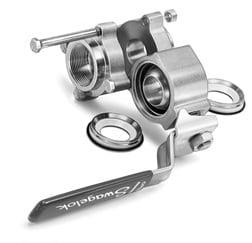Maximizing Component Life in Industrial Fluid Systems
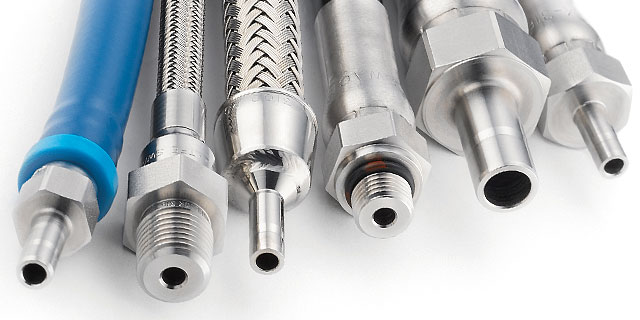
Maximizing the Life of Industrial Fluid System Components
Cory Cottrill
The cost of replacing a single fluid system component in a plant goes beyond the price of the part. A single replacement also encompasses the internal costs for procurement, installation, and maintenance, as well as costs associated with lost productivity during downtime.
While you never want to compromise safety, it’s critical to keep costs down while obtaining the longest life possible from your components. Through decades of experience, Swagelok field engineers have discovered several strategies that not only help maximize the life span of your fluid system components, but also reduce maintenance costs and improve overall plant safety.
Focus on System Design First
Fluid system design affects many variables that act on a component: pressure and temperature fluctuations, water hammer, vibration, and contamination, among others. Such variables can affect not only component life, but the life of the system as well. It’s important to follow sound design practices that limit these stressors to realize long-term performance.
If you are changing a system design, be sure to check the new operating parameters, such as temperature and pressure, against the manufacturer’s ratings for all components. This will ensure your components fall within the acceptable range. Even a seemingly small process change, such as increasing the frequency of hose steam cleaning, deserves attention. The additional heat exposure may decrease the life of that hose from five years to one.
Consider Every Operating Condition
When selecting components for fluid systems, consider the entire application. By covering all aspects, a surprise leak or failure may be less likely due to a component being unsuited for some element of the application.
Here are some important details to consider:
- Normal operating temperatures and pressures
- Maximum operating temperatures and pressures
- Ambient temperatures and conditions, including external exposure
- Process fluid and external media exposure
- Vibration potential
- Tubing and other supports
- Cleaning protocols
Among operating conditions, process fluid compatibility is often overlooked. You will want to ensure all the materials in contact with the process fluid, including O-rings and packing, are compatible. Otherwise, the system component could fail prematurely. Also, be sure to consider external conditions like high-chloride (saltwater) environments, which will accelerate the corrosion of some alloys, such as 316 stainless steel. These conditions may warrant special material choices, such as jacketed tubing, special clamping or tubing support options.
Train Your Installers for Proper Component Installation
Even the best fluid systems designs and components can be compromised by missteps during installation — undoing all the careful work and resources your plant has invested.
Installation mistakes can lead to many issues resulting in premature product failure. Tubing that isn’t bent correctly can experience side-load stresses that may lead to cracks and leaks. Improperly supported tubing exposed to vibration may be prone to cracking and assembly leaking. Internal seals in valves and regulators may wear unevenly if the component is installed on its side.
Certain component features lend themselves to easier installation. For instance, fittings with a low torque requirement are more likely to be tightened properly, especially when combined with a helpful visual tool like a gap gauge.
Your best insurance for proper fluid system component installation is training. While the installation procedures for many components may seem like common sense, small details can make a big difference in the long-term performance and safety of a component. Training courses can help reinforce proper installation techniques to mitigate leaks and enhance safety.
Perform Preventive Maintenance
Some fluid system components require maintenance to realize their lifecycle potential. Regulators, valves and hoses all require regular attention and inspection. In many cases, maintenance or repairs on these components can be performed at a low cost, and the payoff is huge in terms of extended life. Consider the replacement of the packing in a utility valve to prevent internal leaks across the seat. If the valve swings open in line, as some models do, this is an easy and simple repair.
Keeping records of your preventive maintenance program will help you determine whether particular components are being replaced too often. In such cases, an analysis of the component can help you understand the frequency of replacement. Perhaps another component would be better suited to that application — allowing it to last longer and cost less over time. Swagelok’s field engineers can perform evaluation and advisory services in your facility and help develop a custom maintenance plan for your systems.
Store Parts Properly
It’s important to keep a replacement inventory of specific system-critical components. However, you must be careful how you store these components. In the case of hoses, improper storage can lead to damage. You should never stack hoses — instead, hoses must be hung to ensure they are not bending more than the manufacturer’s published bend radius. In addition, protect hoses from ultraviolet (UV) light, as some hose materials degrade from UV exposure. Finally, cap both ends of the stored hose to prevent contamination of the interior.
In the case of other fluid system components, avoid mixing spare parts from different manufacturers in the same bucket or box. Spare parts like ferrules, O-rings, and valve packings need to be separated and stored by manufacturer. It is also important that each spare part is clearly marked for their corresponding component. These parts are not interchangeable — even if they appear the same to the naked eye. Intermixing or interchanging parts from different manufacturers may lead to leaks, corrosion, or product failure.
Learn as you Replace
Replacing fluid system components is a necessary part of running a plant, but you may be able to prolong component life by reviewing your practices related to system design, component selection, installation, maintenance, and storage.
When you must replace a worn out or damaged component before its replacement interval, it is important to understand why. There’s always a reason for component failure and evaluating the cause of failure may uncover a need for a different part or manufacturer. If the part experienced a failure due to pressure, temperature, or material incompatibilities, you may be able to select an alternative that meets the process requirements. If the failure was due to a system-related issue such as vibration, contamination, or water hammer, you can correct the issue in your system to increase the component life — and your bottom line.
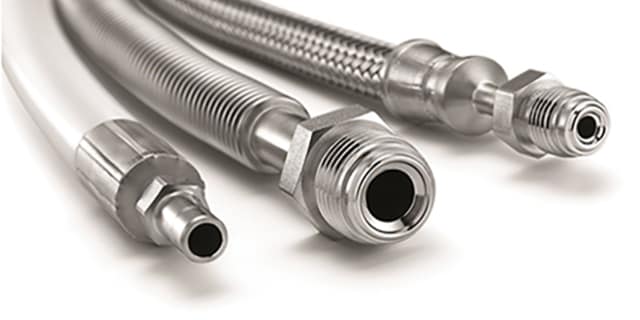
How an Industrial Hose Maintenance Plan Could Save Your Plant Thousands
Knowing the proper time to replace your industrial hoses can save your plant thousands in maintenance costs. Learn how to evaluate your systems and develop a preventive maintenance plan to manage the health of your hoses.
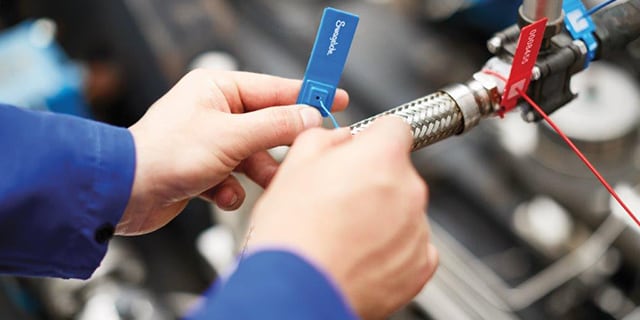
How to Improve Your Maintenance Program with Valve and Hose Tags
Hear from two Swagelok specialists how a robust tagging system for hoses and valves throughout your industrial fluid systems can help you simplify maintenance and minimize system downtime.
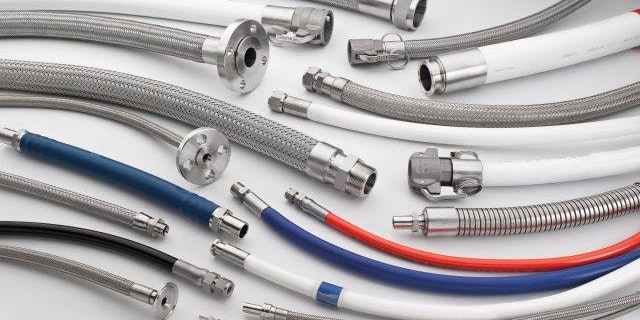
3 Steps to Hose Safety & Lower Plant Costs
Industrial hose safety is often deprioritized during regular plant maintenance. It is important hoses receive the attention they deserve—leaks and wear can put your facility at risk. Learn tips to avoid dangerous situations while lowering plant costs.


